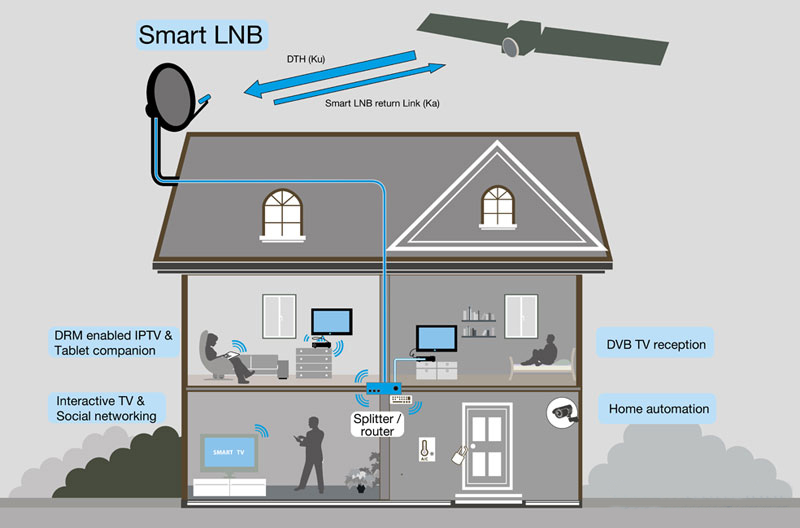
Receiver controls LNB via coaxial cable. And the satellite signal reflected from antenna will be transmitted to satellite receiver and demodulate programs after first frequency conversion through LNB.
Local frequency: Every LNB has fixed LO, C-band is 5150MHz, In Ku-band, set the LO according to the different frequency. Among 10.7-11.7G, the LO is9.75G; while among 11.7-12.2GHz, we often choose10.75GLO, as well as 10.600 and10.678G; among 12.2-12.75GHz, we often choose 12.25GHz or 11.3GHz as LO. At present, most of the KU-band programs adopt this kind of LO.
The category of LNB: According to receiving frequency, it can be divided into C-band and Ku-band LNB. The former is with large volume and the later is with small volume. According to polarization mode, it can be divided into single polarization and dual polarization LNB. For personal family receiving, it should use dual polarization LNB; cable project just needs single polarization LNB. According to the structure, dual polarization LNB is integrated LNB, also called LNBF; Single polarization LNB is separated type, also called LNB, which needs to match feed separately. Now we also call them LNB in general. According to LO frequency, it can be divided into Single LO and double LO LNB.
Technical specification: The standard to judge the quality of an LNB is noise figure. The better the LNB quality is, the smaller the diameter of the corresponding receive antenna should be. For a C-band LNB, the noise temperature is shown with °K, and the smaller the better. At present, some good-quality LNB has reduced its noise temperature to 17°K.
Ku-band LNB shows its noise temperature with dB and the smaller the better. For a good Ku-band LNB, its noise temperature should be 0.7dB. And some Ku-band LNB shows with gain. The gain of a good LNB should reach 65dB.
For customers use the same receive antenna with another one or other ones, C-band dual LO LNB will appear mutual interference of two polarization mode when receiving dual polarization satellite like Apstar. This matter always troubles customers. But C- band dual LO LNB has solved this problem effectively. In the past, it’s impossible to use a dual polarization LNB by multiple users to receive Apstar orAsia3s satellite, because the two polarizations have conflict when operating on 13/17V voltage. The two polarizations of PX-1200 both work on the same voltage, the range can be optional between 13~18V. For the signal of different polarization mode, it is divided based on different LO frequency. When horizontal polarization works on5150MLO, the vertical polarization will work on5750MLO. Then the multiple receivers can work on PX-1200 at the same time, and one antenna can receive programs from different polarization by many customers without interference.
Because the Ku-band programs has wide frequency range, the corresponding Ku-band LNB can be divided into standard, extended and full band. The extended band is a relative concept. As we know, Ku-band signal works on11Gand12Gfrequency, among which there are 10.7-11.7G, 11.7-12.2G, 12.2-12.7Getc. So to speak, the LNB only working on these three frequency ranges is so-called narrow-band LNB. Relatively speaking, frequency like 11.7-12.7Gcan be called extend band. And the LNB used to receive signals from 10.7-12.7Gcan be called full band. Now there are many Ku-band satellite TV programs of11Gsignals except common12Gsignals in APAC.
The frequency range of wideband LNB is 11.7-12.7G, common LO frequency is10.75G.
Standard LNB refers to LNB with 11.25 or11.30GLO and receiving 12.2-12Gsignal.
Full band LNB refers to LNB receiving all the signals in 10.7-12.7G. This kind of LNB is all dual LO. The low LO is9.75G, which is to receive signals in 10.7-11.7G; while high LO is usually10.75G, also 10.6,10.678Getc, which is to receive signals in 11.7-12.7G. This kind of LNB is controlled by the 0/22KHz switch in digital machine. When switch is off, LNB works on low LO; when switch is on, LNB works on high LO.
The category of C-band usually adopts: ordinary dual polarization LNB, such as PC-900and PC-900S; engineering single polarization dual output LNB, such as PUSISAT PS-1600, with one horizontal interface and vertical interface; Dual LO dual output LNB, such as PUSISAT PS-1220suitable for two families with one antenna; Dual LO four output LNB, such as PUSISAT PS-1240suitable for four families with one antenna; Dual LO LNB, such as PX-1200suitable for more than five families with one antenna.






